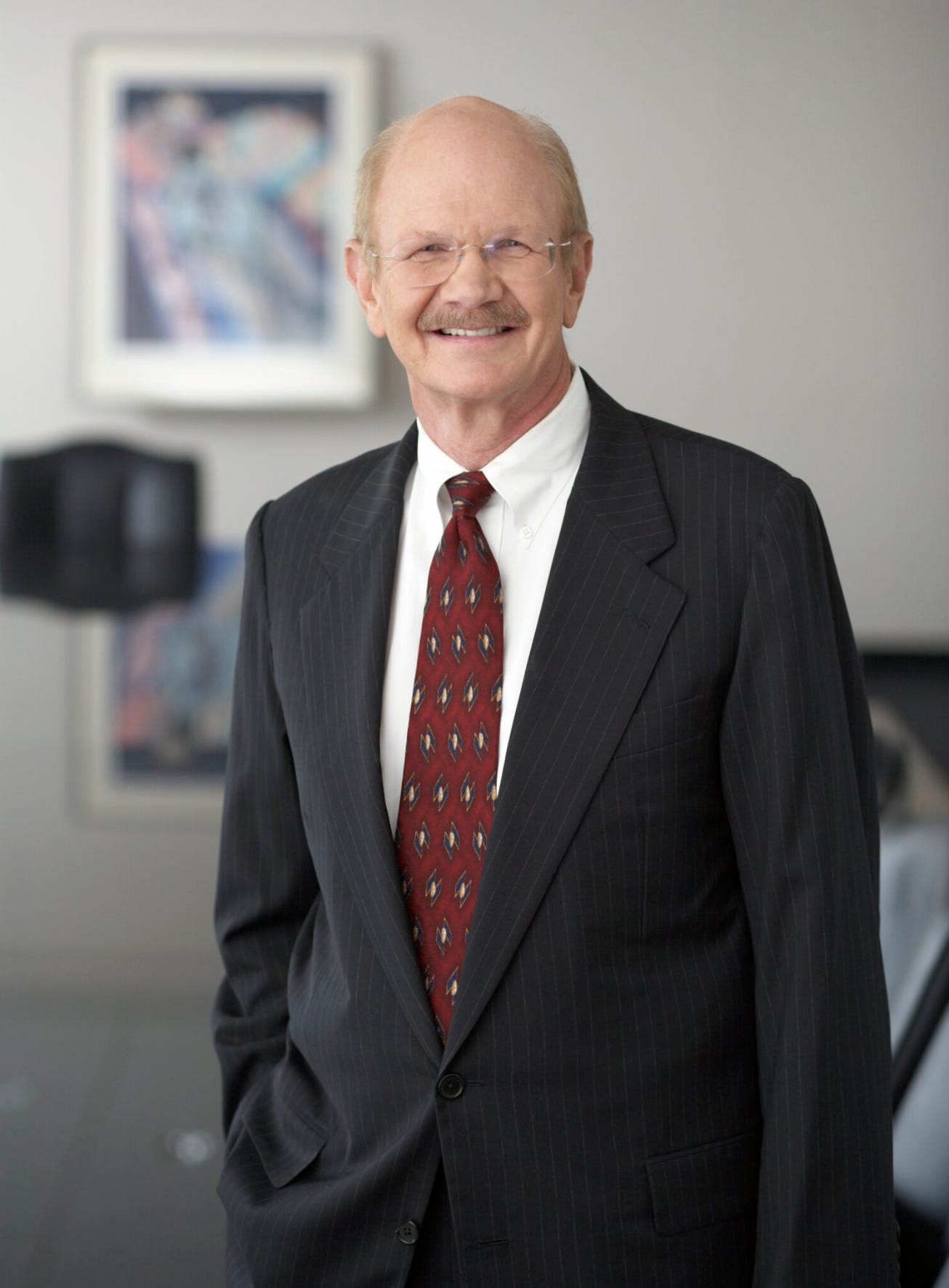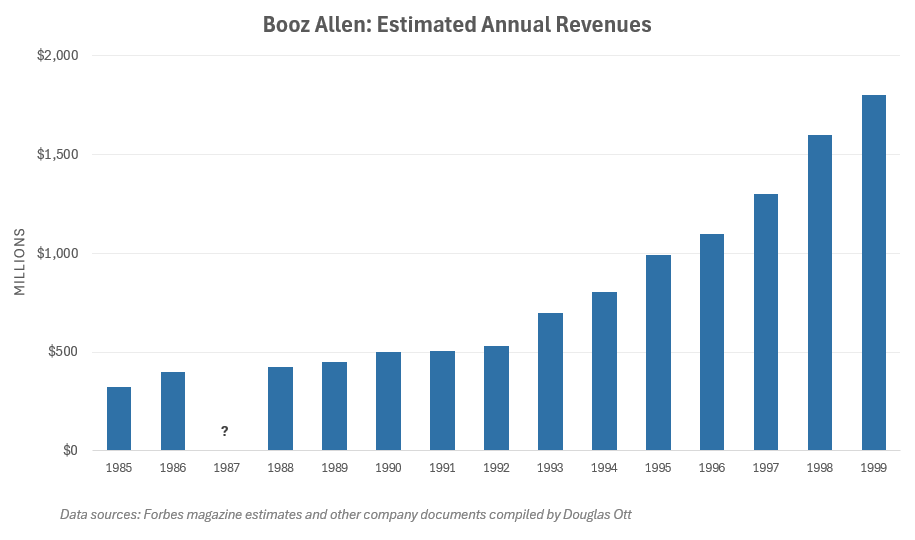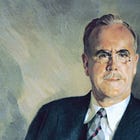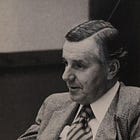“In 1990, when Bill Stasior became chief operating officer of Booz Allen…he flew to Florida to meet with General Wayne Allan Downing, director of the U.S. Army Special Operations Command, for a client’s-eye assessment of a classified consulting engagement. The general arrived flanked by officers in military gear. Obviously, they all had just come straight from a paratrooper exercise. Taken aback by the fierceness of their appearance, Stasior was relieved when the general said, ‘We thought we’d hired just another contractor, but you guys have come in and already had a tremendous impact. Your people are making our mission their mission.’”
—Booz Allen Hamilton: Helping Clients Envision the Future (page 71)
By 1980, annual revenues at Booz Allen had climbed to $180 million, more than tripling in a decade. The firm was now the second largest in U.S. consulting service billings after Arthur Andersen. Growth came from longstanding client relationships (such as the U.S. Navy) and the entry into new industries domestically and abroad. Booz Allen also sought new industries to serve. For example, Warner-Lambert Company became a client, which marked the firm’s entry into health care consulting. Internationally, Booz Allen consulted on oil and steel industry work in West Africa, Indonesia, and Nigeria. The firm also assisted Zambia in consolidating its copper mining industry.
However, the early 1980s also presented new headwinds. By 1983, recessionary conditions and an oil glut led to a profit slump for Booz Allen. To compound matters, James Farley would be stepping down as chairperson and chief executive of BAH in 1984. To choose his successor, he initiated a “horse race”. A 1988 Forbes article describes the process:
“In 1983, his 54th birthday approaching, Farley came up with the idea of setting up a winner-take-all horse race among his top partners: Though he would chair the nominating committee, Farley would stay out of the process and leave the decision making on a successor to a democratic process, corporate-style.”
Farley established a selection committee of 15 partners to choose his successor for him. Anyone interested in the job should step forward, and he would be considered.
As Farley envisioned things, the committee would interview each and every partner of Booz, Allen’s 37 offices worldwide about the self-declared candidates. The committee members would probe for what qualities the partners would welcome in a leader, what qualities would be unwelcome, and more generally, what ought to be done with the firm itself in the future. As a final and deciding step, the committee would interview each candidate individually.”
Seven of management’s best and brightest declared they would run, and the race was on. It was a a disaster.
Why was the race a disaster? Well, it was an enormous distraction for the firm as well as its clients. Booz Allen’s John McGrath spoke to Forbes about being a candidate in the process:
“‘It was like taking your clothes off in the middles of a street. It is very, very tough.’ The process took ten months, distracting for the firm and candidates alike.”
The winner of Farley’s race—or rather, gladiators’ contest—was 45-year-old Michael McCullough. He won for a few reasons. First was simply his age. Booz Allen had a rule that the CEO must step down at age 55 to return to consulting work. McCullough had a natural advantage in that he would have a fulsome 10 years to lead the firm. Secondly, and perhaps equally important, was that McCullough “was a relative unknown to most of his peers.” Finally, he was in charge of a line of government business that had grown quickly thanks to President Reagan’s generosity towards the defense budget.
The fallout from this horse-race was truly unfortunate. Many at the firm saw it as divisive and an unwelcome interruption to serving clients. Between 1984 and 1988, Forbes reported that “roughly a third of the firm’s 176 partners” quit. Furthermore, Booz Allen’s commercial consulting group was “decimated”, which in turn left the firm “excessively reliant on government work, the lowest-margin, most labor-intensive side of the business.”
The Michael McCullough Era
After his ascension to leadership, McCullough responded to the challenges of the mid-1980s with three major changes. First, he restructured the firm around industries rather than traditional geographic boundaries. With this first change, McCollough also implemented a multi-disciplinary approach to solving business problems whereby technical specialists were teamed up with management consulting experts. This approach was relatively novel at the time, as most firms specialized in either management or technology. The results were positive and allowed Booz Allen to stand out from its competitors. According to Booz Allen’s 90th Anniversary book (Booz Allen Hamilton: Helping Clients Envision the Future):
“This improved the quality and consistency with which Booz Allen could serve global corporations and other clients spanning regions, plus it improved collaboration among regional partners who formerly competed with one another. At the same time, a functional orientation focused on in-depth, cross-industry implementation projects (such as supply chain management, information technology, and operations) became an additional source of strength for the firm. Facing the market along industry lines and functional lines, instead of geographic ones, opened the door to more client-centered consultations. No other consulting firm had ever brought that combination of sector and functional expertise to executive level strategic consultation.”
The second big change was the compensation system for the partners. After the firm went private via a management-led leveraged buyout in the late ‘70s, the comp system was geared “to encourage rainmaking at a time when the firm badly needed cash.” Each partner had their own different bonus for the year based primarily on the size of billings. McCullough’s new compensation scheme would be informed by the growth of the entire firm.
“‘The new concept was very simple,’ McCullough recalls. ‘We’d try to make the pie bigger instead of competing over the size of the slices.’ With then-Vice President Andy Messina, McCullough installed a series of partnership levels and a point system to allocate bonuses to each. The size of the bonus was set by the performance of the entire firm. Partners now had a built-in incentive to encourage each others’ success, to seek business together, to collaborate on behalf of client needs, and to cultivate trust.”
McCullough’s third change was to make it easier to grow internationally. Although Booz Allen had done international work in the past, chairman Jim Farley chose not to invest the resources to make international a true priority. Thus, McCullough simply lowered the financial hurdles and requirements for setting up offices outside the U.S. to cultivate this opportunity.
Amidst McCullough’s changes, the firm also tried to create a more diversified book of business, but to little avail. Booz Allen still relied heavily on government work during the mid-1980s. At the same time, rival McKinsey & Company became a leader in general management consulting while Arthur D. Little specialized in technology consulting. By 1987, government accounts were nearly one-third of Booz Allen’s $340 million in annual revenues. And this was at a time when defense spending faced potential budget cuts.
Another important initiative for Booz Allen came in 1989, when the firm launched a major expansion program of its computer systems integration (CSI) services for commercial clients. This move positioned Booz Allen in a rapidly growing and highly competitive segment, requiring them to compete with both computer manufacturers and technology consulting firms.
The William Stasior Era
Despite a recession in 1990, Booz Allen produced record results. The firm now had a total of 4,100 employees and annual revenues had grown to an all time high of $500 million. All of the business segments had done well, but rapid international growth—seeds planted by McCullough—was a large contributor.
However, McCullough, was now 52 years old and chairman since 1984. He was just three years away from the maximum tenure allowed under the firm’s rules, which was likely not enough time to successfully deal with trouble brewing among the partners of the firm regarding the rationale of serving both commercial and government clients. Thus, McCullough relinquished the leadership post earlier than required to return to consulting work as a senior partner.
Regarding the growing identity crisis at Booz Allen, many partners just couldn’t reconcile having two disparate business lines. The commercial business competed against the likes of McKinsey, Boston Consulting Group, and Bain. The commercial partners “often worked alone or in very small teams, traveled frequently, consulted on a short-term basis in many cases, and often operated entirely at their own discretion and that of the client.” These partners felt Booz Allen should sell or spin off the government business.
On the other hand, the public sector partners focused on large projects with large teams of specialists that generally stayed in one geography. At this point in time, the competition for government business came from the likes of SAIC, Electronic Data Systems, and the consulting arm of Computer Sciences Corporation. It was natural that some partners viewed the government business as distracting to the commercial business, and vice versa.
And yet there were also some partners that saw benefits from having both businesses under one roof. These partners felt there was an emerging trend of clients demanding the experience and competencies Booz Allen had developed from working on public and private assignments.
This debate culminated in the appointment of William F. Stasior as the next leader of the firm. Stasior became president and chief operating officer in 1990 and then assumed the duties of chairman and CEO in 1991. He was the sixth chairman since Booz Allen’s founding in 1914.
Stasior had a master’s degree in electrical engineering from Northwestern and except for a year at the Argonne National Laboratory in Chicago, he had worked at Booz Allen his entire 24-year career after school. He joined the firm in 1967 and became a partner in 1976. Importantly, Stasior had been responsible for starting and growing the firm’s technology consulting business.
There were two areas Stasior focused on. First was reorganizing the firm to focus on two distinct lines of business: the public sector and the private sector. Stasior firmly believed in the value of keeping both the commercial and government businesses. As part of this reorganization, and as a signal of the growing importance of the public sector to the firm, Stasior moved the headquarters to McLean, VA to be closer to its important government clients. Second, Stasior continued Booz Allen’s global expansion, opening offices in Abu Dhabi, Bangkok, Bogota, Frankfurt, Mumbai, Pretoria, Seoul, and Shanghai. By 1996, Booz Allen had offices in 90 geographies.
After leading Booz Allen for eight years, Stasior would step down at the end of 1998 to make way for Ralph Shrader. Booz Allen’s annual revenues had grown from $500 million to $1.7 billion during Stasior’s leadership. The firm had won many significant government contracts. One was a 1996 contract (worth up to $620 million) with the General Services Administration to provide technical and management support for all federal telecommunications users. Another was a 10-year, $200 million contract in 1998 with the Department of Defense to create and maintain a scientific and technical data warehouse. On the commercial side, although it was not a significant contract, Booz Allen played a role in 1996 in building Standard & Poor’s new customized client/server architecture and managing the risk of pulling the plug on S&P’s mainframe systems. This was the type of complex, technical, and mission critical work that continued to define the firm on both the public and private side.
Please stay tuned for Part IV of this series on the history of Booz Allen Hamilton where we go over the era of Shrader’s leadership during the dot com bubble and bust, the global war on terror, private equity firm Carlyle Group taking an ownership interest in firm and how and why Booz Allen went public for the second time in its existence.
If you missed out on the first two parts of this series, you can find them below:
Sources and Further Reading
“CONSULTANT AS BOSS: James B. Farley; Breaking All the Rules”, New York Times, Sept. 11, 1988.
“Gladiator’s ball”, Forbes, Dec. 26, 1988.
“Top Officer for Operations Is Appointed by Booz, Allen”, New York Times, April 3, 1990.
“Booz, Allen’s Chief Says He’ll Step Down”, New York Times, Feb. 14, 1991.
“Booz, Allen & Hamilton Picks New Chief Executive”, New York Times, April 13, 1991.
“Proceeding With Caution”, CIO, October 15, 1996.
Kleiner, Art. Booz Allen Hamilton: Helping Clients Envision the Future. Old Saybrook, Conn.: Greenwich Pub. Group, Inc. 2004.
“Official Caddying Story: Bill Stasior”, Caddyshack to Corner Office, accessed April 12, 2025.
“Booz Allen & Hamilton Inc.”, Encyclopedia.com, accessed March 12, 2025.
“Booz Allen & Hamilton Inc. History”, FundingUniverse.com, accessed March 12, 2025.
Disclaimers for this Substack
The content of this publication is for entertainment and educational purposes only and should not be considered a recommendation to buy or sell any particular security. The opinions expressed herein are those of Douglas Ott in his personal capacity and are subject to change without notice. Consider the investment objectives, risks, and expenses before investing.
Investment strategies managed by Andvari Associates LLC, Doug’s employer, may have a position in the securities or assets discussed in any of its writings. Doug himself may have a position in the securities or assets discussed in any of his writings. Securities mentioned may not be representative of Andvari’s or Doug’s current or future investments. Andvari or Doug may re-evaluate their holdings in any mentioned securities and may buy, sell or cover certain positions without notice.
Data sources for all charts come from SEC filings, Koyfin, and other publicly available information.










dont you expect a real bad earning season for BAH? Lot of contracts were cancelled, doesnt it?